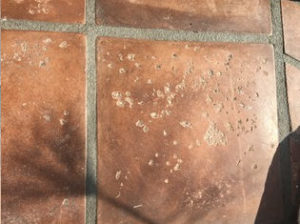Q: We live in Los Angeles County, California. We extended our concrete patio in 2013 and had it finished with concrete patio tile that look like terra-cotta. We were told this tile is more expensive, but it will last us a lifetime. There is a lifetime warranty on this material. Now – only 6 years later – the tile is blistering and corroding.

We contacted the tile manufacturer who told us that we used the wrong sealer and that they had the same problem on another project where this sealer was used. After telling them that this sealer was recommended by their vendor where we purchased the tile, the manufacturer is now telling us that the concrete on our patio should also have been sealed before the tile was installed.
We are no longer able to contact the contractor who installed the tile to determine whether a sealer was used. We have no record of being instructed that this tile requires a moisture barrier before being installed or any other special installation requirements. If it turns out (after taking up some tile) that the concrete was not sealed, would this void a lifetime warranty of the material?
We would appreciate your advice very much! Thank you. — Karin
A: Sorry to hear about your situation. To my ears, it sounds like the tile manufacturer is trying to weasel out a warranty claim. This, sadly, is the outcome of many warranty claims for faulty building materials. Determining whether the product is faulty, the installation or use was flawed, maintenance was inadequate, or some combination of these factors, is never easy to determine.
Too many manufacturers take advantage of this inherent ambiguity. Their first response to many warranty claims is that the installation, use, or maintenance was faulty – leaving you with the burden of proving otherwise. Sometimes the warranty has such unreasonable limitations or installation instructions that almost no one can claim to have followed all the rules.
Nearly all building material warranties are “limited” warranties which state what costs the manufacturer will reimburse and under what conditions. Under certain prescribed conditions, the manufacturer bears no responsibility for the failure. In other cases, they may be responsible for some, but not all, of the costs to repair and replace the defective product.
In addition, many construction product warranties are for the material only, and do not cover the labor costs to repair and replace the defective product. Some warranties are also pro-rated, based on the number of years the product has been in service. So the amount of money actually paid out on a valid claim may represent only a small fraction of the total repair cost. For example, you may receive a box of new tiles worth $50, but not the $1,000 for the labor and materials to tear out and replace the damaged tiles.
Unless you have a copy of the original warranty, you have no way to know what exactly is covered. If you don’t have a copy of the warranty, request a one from the manufacturer. You may also be able to find a copy of the warranty on their website.
As a practical matter, any tile sold with a “lifetime warranty” for exterior use should either be glazed or otherwise impervious to water. If the tile is unglazed and porous, it should come with explicit instructions for sealing. If the instructions do not name specific sealers, contact the manufacturer for recommended products. In general, the sealers keep out water from rain and snow, and provide some UV protection.
With most porous pavers and exterior tiles, sealing is not required. However a high-quality sealer will help make cleaning easier and prevent staining from leaves, grease, cooking oils, and other staining liquids. Sealers should also reduce efflorescence which can occur when some masonry materials absorb water and then release dissolve salts. The downside to sealing is that you will need to re-seal the tiles every year or two to maintain the protection.
If you don’t seal, your tile should not rapidly deteriorate any more than standard bricks, which can last for decades on a patio without problems. So blaming the rapid deterioration of your tiles on not sealing or using the wrong sealant does not seem legitimate.
Sealing the concrete slab prior to installing the exterior tile is also not a typical requirement. You would only need a sealer if you have wet conditions under the slab — a problem that is better addressed with proper drainage. Also, some concrete sealers are not suitable for tile. In fact, curing compounds and other coatings on slabs can interfere with the bond to the tile.
The best practice for applying tile to concrete is to use a crack-isolation membrane over the concrete. This prevents cracks in the concrete from “telegraphing” through, creating cracks in the tile surface. Many crack-isolation membranes also serve as a waterproofing layer, although the waterproofing is mainly needed where wood framing lies under the tile.
In either case, choose a crack-isolation membrane specifically formulated for the type of thin-set mortar you are using to install the tile. For example, some membranes only work with latex-modified thinset, some only work with unmodified thinset.
I suggest contacting the California Dept. of Consumer Affairs to see what recourse you might have. If you contractor were still in business, you could file a complaint with the Contractor’s State License Board. Even so, I suggest contacting the board to see what they can offer. You should also consider filing a complaint about the manufacturer with the Better Business Bureau. Finally, a lawyer’s letter can sometimes help motivate the manufacturer (or contractor) to do the right thing. Sometimes it takes a class-action lawsuit to get manufacturers to act where there have been widespread product failures.
Best of luck in getting the manufacturer to honor their “lifetime” warranty. — Steve Bliss, Editor, BuildingAdvisor.com
Related Links: Construction Warranties Warranties & New Home Defects
Leave a Reply